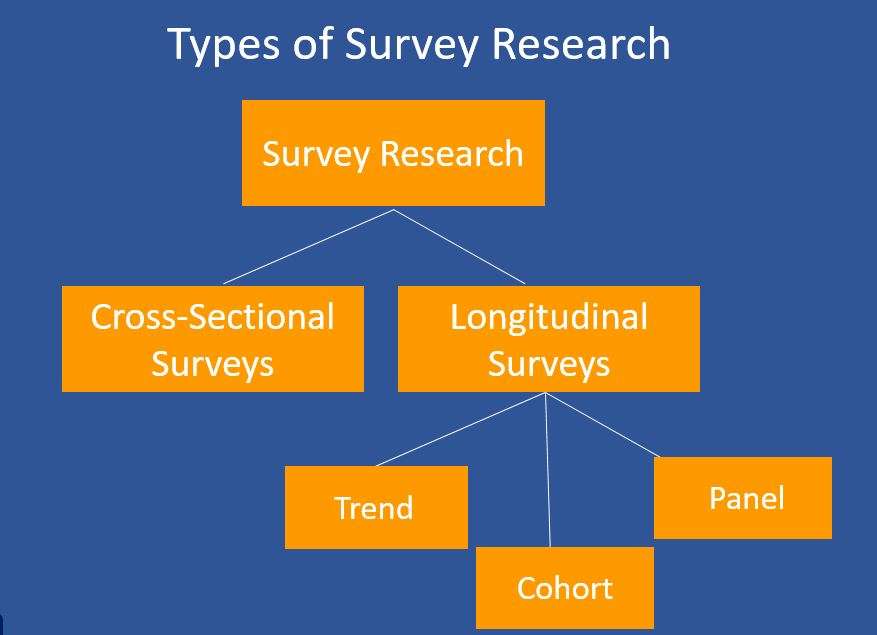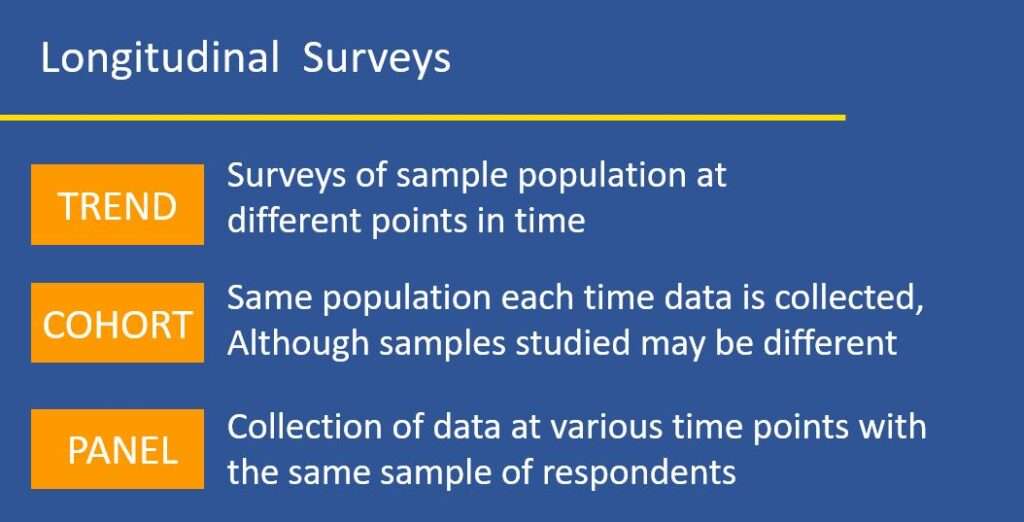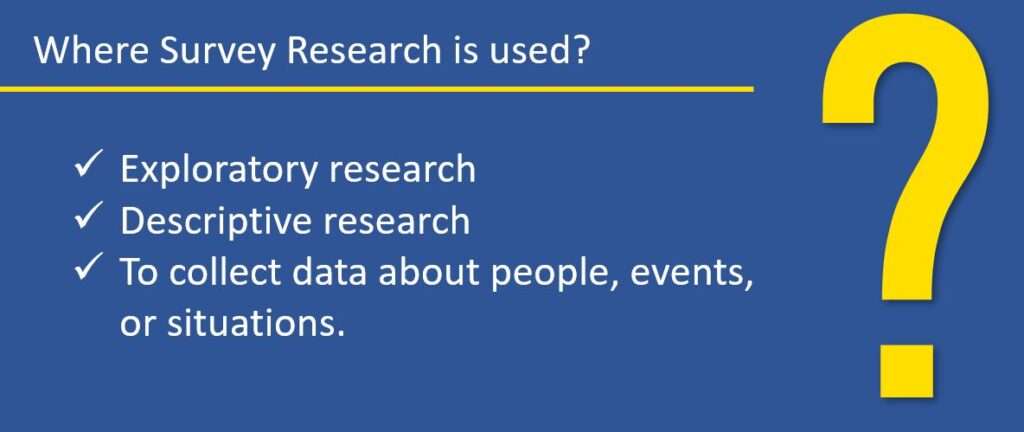What is Survey Research?
Survey research is the process of collecting and analyzing data about target populations or respondents to answer specific research questions. In this article you will learn what is survey research? types and uses of survey research
It is a type of research method that involves asking people (or another source) specific questions in order to understand their views, beliefs, and behaviors in relation to a topic of interest.
A survey is a sample of a larger population and often seeks to represent the entire population. The survey method is used in many different disciplines, but the context and content of the survey will vary depending upon the population, timeframe, and other factors.
Surveys may be one of the most cost-effective ways of collecting data, but they are also subject to a range of potential biases, errors, and inaccuracies.
The survey strategy is very popular in business research, because it allows the researcher to collect quantitative and qualitative data on many types of research questions.
Indeed, surveys are commonly used in exploratory and descriptive research to collect data about people, events, or situations.
For instance, in a business context, surveys are often taken on the subject of consumer decision making, customer satisfaction, job satisfaction, the use of health services, management information systems.
Such surveys predominately consist of one-time surveys. Other surveys are continuing, allowing the researcher to observe changes over time.

Typically, the survey questions are organized into self-administered questionnaires that a respondent fills out on their own, either manually or digitally. Other survey instruments are interviews and structured observation.
Types of Survey Research

of Survey Research
There are two types of survey research methods:
- Cross-sectional surveys
- Longitudinal surveys
What are Cross-Sectional Surveys?
These surveys collect data from a sample of people at a single point in time. The data may relate to their health, education, employment, or other topics.
Cross-sectional surveys are useful if you want to measure the prevalence of something in a population.
Example:
They can determine the percentage of people who own a smart phone. Although these surveys use a sample of the population, researchers can’t generalize from this sample to the entire population because they don’t know whether the sample accurately represents the population.
Another example is that if a survey about school funding is conducted at a robotics competition for high school students, the results might not accurately reflect the views of all high school students.
What are Longitudinal Surveys?
These surveys collect data over time (usually a few years) from the same respondents. The data may relate or not to the respondents’ health or employment.
Longitudinal surveys are useful if you want to see how outcomes change over time.
Example:
They can follow the same people over time to see how they experience the death of a loved one or how they fare in finding new employment after a layoff.
As in cross-sectional surveys, researchers can’t generalize from the sample to the entire population. For example, they can’t conclude that because a few people in a sample experience a terrible outcome, most people will suffer the same fate.
Longitudinal Surveys are further divided into
- Trend
- Cohort
- Panel

Trend surveys are the surveys of sample population at different points in time.
Cohort survey is the study of same population each time data are collected, although samples studied may be different.
Panel survey is the collection of data at various time points with the same sample of respondents.
Why is Survey Research important?
Survey research is important because it has the potential to provide us with deep insights into human behavior by helping us understand what people are thinking and doing in their lives.
It allows the researcher to collect quantitative & qualitative data on many types of research questions.
Survey research can be used to explore many different topics and is used by a wide range of disciplines.
It can provide rich information about our social and health behaviors, our experiences and perceptions, and our knowledge and understanding of the world around us.
Survey research can help inform policy decisions and improve social service delivery. It can also help people better understand themselves, their experiences, and the world around them.
This self-knowledge can be helpful in many ways, including in guiding future research, making decisions in education and employment, and planning for retirement.
Survey research can be useful for individuals, communities, and countries all over the world.
Like all research methods, it does have limitations, but it can provide valuable insights when used appropriately.
Learn more: Research Methods: Definitions, Types
Where Survey Research is used?
Surveys are commonly used in exploratory research, and descriptive research, to collect data about people, events, or situations.

Survey research is used in many different disciplines and settings. It can be used to understand a wide range of topics and phenomena, including social, economic, health, political, and environmental issues.
Survey research is used in both research and practice in a wide range of disciplines and organizations. It is used in both academic and applied settings and in governmental and private sector organizations.
Many disciplines, including anthropology, economics, sociology, public health, communication, political science, and psychology, use survey research to explore different topics.
Organizations that use survey research include government agencies, private foundations, non-governmental organizations, corporations, media companies, and academic departments and research centers.

In a business context, surveys are often taken on the subject of consumer decision making, customer satisfaction, job satisfaction, the use of health services, management information systems.
Limitations of survey research
Survey researchers need to consider a number of issues when designing and conducting surveys. For example, they need to consider the potential for bias in their survey questions and how their survey design might affect the sample they end up with.
Potential for Bias in Survey Questions
When writing questions for a survey, researchers must be careful to avoid bias in their questions. Bias can lead to incorrect conclusions about people’s perceptions and beliefs.
For example, a survey question about health might ask, “How healthy do you feel?” This might be interpreted differently by different people.
Potential for Bias in Sample
Samples can represent the populations from which they are drawn in a number of ways. There are different types of samples that researchers can use when designing a survey.
The most common types of samples are random samples, non-random samples, and convenience samples.
Potential for Sample to Affect Generalizability
Sample drawings and selection procedures can affect the generalizability, or applicability, of survey results.
For example, if researchers use a random sample of city residents, and their survey results indicate that city residents generally support building a new library, it would be incorrect to conclude that library support is high throughout the city.
Potential for Bias in Questionnaire Design
Questionnaire design affects the quality of survey results. Researchers who conduct their own surveys should carefully consider the design of their questionnaires.
Potential for Questionnaire Design to Affect Generalizability
Questionnaire design can affect the generalizability of survey results.
For example, if a researcher asks respondents to rate their satisfaction with local government service on a five-point scale, and their results indicate a high level of dissatisfaction, it would be incorrect to conclude that people generally are dissatisfied with government service.
Examples of survey research
In public health: Survey research is used to examine how people experience and understand their health, how they take care of themselves, and how they interact with health care providers.
For example, researchers might explore how people understand and use genetic testing for genetic susceptibility to disease.
In social science: Survey research is used to examine people’s social experiences and relationships, values and beliefs, and social and cultural identities.
For example, researchers might explore people’s understandings of gender and how gender affects social relationships.
In economics: Survey research is used to examine people’s economic decisions and experiences, such as how people save for retirement or how they make purchasing decisions.
For example, researchers might explore how people decide whether to use a traditional or Roth individual retirement account.
In sociology: survey research is used to examine people’s experiences in and understandings of social groups, such as racial or ethnic identity, or religious identity.
For example, researchers might explore how people understand their race or ethnicity and how such identities affect social relationships.
In communication: Survey research is used to understand people’s uses and experiences of media, such as how people use social media, how they view video content, or how they receive and understand news and information.
For example, researchers might explore how people use different forms of social media and what they like and dislike about those platforms.
In political science: Survey research is used to understand people’s political views, such as their political identities, political beliefs, or voting behaviors.
For example, researchers might explore people’s attitudes toward the Iran nuclear deal or their voting intentions in the upcoming presidential election.
Other articles
Please read through some of our other articles with examples and explanations if you’d like to learn more about research methodology.
Statistics
Methodology
- Research Methods
- Quantitative Research
- Qualitative Research
- Case Study Research
- Survey Research
- Conclusive Research
- Descriptive Research
- Cross-Sectional Research
- Theoretical Framework
- Conceptual Framework
- Triangulation
- Grounded Theory
- Quasi-Experimental Design
- Mixed Method
- Correlational Research
- Randomized Controlled Trial
- Stratified Sampling
- Ethnography
- Ghost Authorship
- Secondary Data Collection
- Primary Data Collection
- Ex-Post-Facto
Research
- Table of Contents
- Dissertation Topic
- Synopsis
- Thesis Statement
- Research Proposal
- Research Questions
- Research Problem
- Research Gap
- Types of Research Gaps
- Variables
- Operationalization of Variables
- Literature Review
- Research Hypothesis
- Questionnaire
- Abstract
- Validity
- Reliability
- Measurement of Scale
- Sampling Techniques
- Acknowledgements



